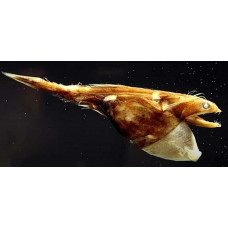Latin name
Chiasmodon niger
Other names
Chiasmodon niger
Identification
No scales. Musculature poorly developed. The body is elongated and compressed. The head is long with a blunt muzzle. Eyes of moderate size. The mouth is very large, with numerous wedge-shaped teeth. The lower jaw protrudes slightly forward; both jaws have a single row of sharp teeth that interlock when the mouth is closed. The first three teeth in each jaw are enlarged into "fangs". The lateral line is firm. Vertebrae: 43-44.
The most characteristic feature is the ability to swallow very large prey, larger than the fish itself. The jaws, body walls, and stomach of this and closely related species are capable of great elongation.
Features of fish fins
The pectoral fins are long with 12-15 (usually 13) rays; the pelvic fins are small and contain 5 rays. Of the two dorsal fins, the first is barbed with 10-12 spines and the second is longer with 26-29 soft rays. The anal fin has 26-29 soft rays. The caudal fin has 9 rays.
Fish colouring
Color is black or black-brownish.
Distribution
Worldwide distribution in tropical and subtropical waters, in mesopelagic and bathypelagic zones.
Habitat
Marine pelagic-oceanic species. Depth range 700-2745 m, usually 750-900 m. Deep sea. Extensive 46°N to 5°S, 95°W to 5°E.
Size
Maximum length 25 cm.
Behavior
Juveniles are found in shallow water, at depths ranging from 0 to 1050 m (average 542 m), with the smallest specimens (>10.0 mm) aggregating closest to the surface.
Food and feeding habits
The Black Swallower swallows its prey whole. Due to its peculiarities, it is able to swallow prey twice its length and 10 times its weight. The articulation of the jaws to the skull allows these fish to grasp objects larger than their own heads. It is believed that they grab prey from behind and swallow it from the tail with the help of movable pharyngeal teeth.
Reproduction
Pelagic eggs, 1.1-1.3 mm in diameter, contain a fat droplet and six darkly pigmented spots. After hatching, the spots are distributed along the larval body from the eyes to the tip of the chorda. These spots then disappear and the entire body becomes black. Larvae and juveniles are covered with small protruding spines.
Fishing
It has no commercial value and is of no interest to fishermen.
Relationship with a person
A species harmless to humans.
| Classification | |
| Phylum | Chordata |
| Class | Actinopterygii |
| Squad | Trachiniformes |
| Family | Chiasmodontidae |
| Genus | Chiasmodon |
| Species | C. niger |
| Features | |
| Conservation status | Least Concern |
| Habitat | Pelagic |
| Life span, years | No information |
| Maximum body weight, kg | No information |
| Maximum length, cm | 25 |
| Sailing speed, m/s | No information |
| Threat to people | Edible |
| Way of eating | Predator |
Black swallower
Tags: black swallower


